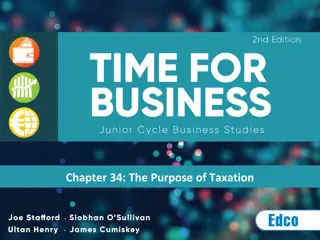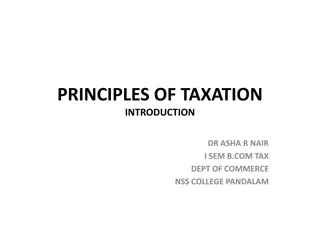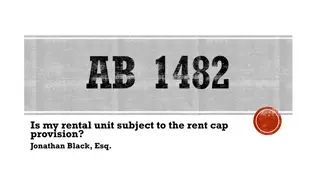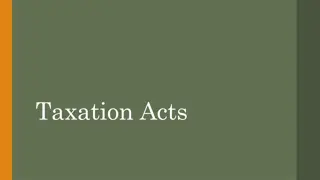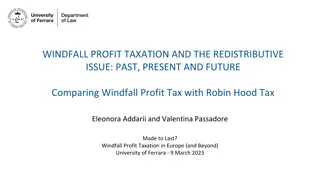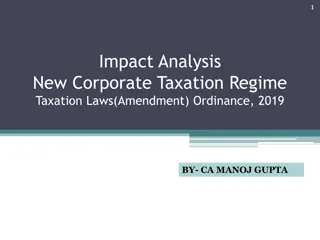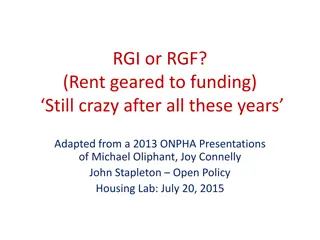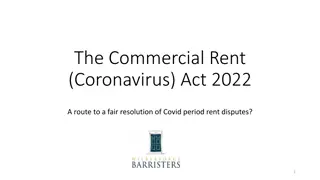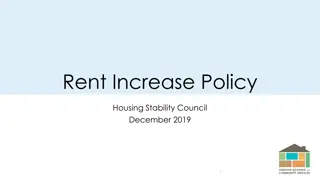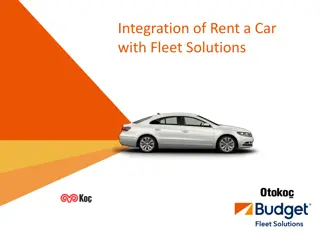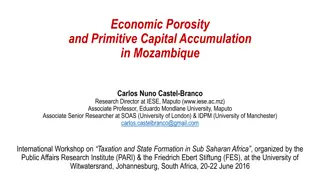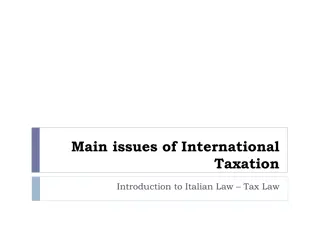Understanding Efficiency Issues in Taxation and Rent Concepts
Exploring the economic concepts of rent, producer surplus, and rent-seeking behaviors in closed economies with tariffs and quotas. Learn about the impact of taxation on efficiency and how it relates to various economic policies and analyses.
Download Presentation

Please find below an Image/Link to download the presentation.
The content on the website is provided AS IS for your information and personal use only. It may not be sold, licensed, or shared on other websites without obtaining consent from the author. Download presentation by click this link. If you encounter any issues during the download, it is possible that the publisher has removed the file from their server.
E N D
Presentation Transcript
Lecture 6: Rent, Tariff, Tax, Subsidy PAI 897 Policy Analysis
Economic Concept of Rent In this setting, we assume there is a minimum acceptable price. For suppliers, the marginal cost of production. The reservation price of the good used car or the lemon we looked at in information asymmetries and adverse selection. The supply of labor as revealed by the supply curve in the minimum wage policy floor example. Economic rent is the amount you are paid over and above what is the minimum you would have been willing to accept.
Producer Surplus is a kind of rent The area under the competitive market price and the marginal cost / supply curve. p p S p* p* S D D q q* q* q Why does supply slope up? Short Run, fixed input gives rise to diminishing marginal product increasing MC Long Run, technology, regulation, environment, scarcity of inputs, location, input costs We sometimes interpret PS as returns to a variable such as proximity to consumers. There is an idea that under competition, the presence of PS (profit) leads to market entry to eliminate the PS to look like the graph on the right with perfectly elastic supply
Rent seeking Closed Economy with no imports. Infant Industry argument; domestic producers protected behind an import tariff behind a quota
Rent Seeking, Closed, Tariff, Open Closed Economy and Tariff Example 30 25 ????????? D 20 15 ?? ?? ?? C ??????+ ? RENT C T 10 TaxRevenue RENT C, RENT T O ?????? 5 Imports T Imports O 0 0 1 2 3 4 5 6 7 8 9 10 11 12 13 14 15 16 17 18 19 20 21 22 23 24 Domestic Inverse Demand Domestic Inverse supply International supply ?? International supply plus tariff ?? ??
Rent Seeking, Closed, Quota, Open Quota allowing 6 units to be imported at the world price 30 Same basic pattern for DWL here as for the tariff 25 ?_???????? D 20 ?_????? 15 C Rent C 10 Q ?_????? Rent C, RentQ O 5 Import amount allowed 0 0 1 2 3 4 5 Domestic Inverse Demand 6 7 8 9 10 11 12 13 14 15 16 17 18 19 20 21 22 23 24 Domestic Inverse supply
Trump Tariffs 2018 The Trump administration has increased taxes on Americans by imposing nearly $42 billion worth of tariffs. These include the following: 25 percent tariff on imported steel, which amounts to about a $7.3 billion tax increase. 10 percent tariff on imported aluminum, which amounts to a nearly $1.7 billion tax increase. Doubled steel and aluminum tariffs on Turkey, which is a tax increase of roughly $0.34 billion. 25 percent tariff on $50 billion worth of imports from China, which amounts to a $12.5 billion tax increase. 10 percent tariff on $200 billion worth of imports from China, which amounts to a $20 billion tax increase. Tariffs on washing machines, which amount to about a $0.15 billion tax increase. (Erica York, Tax Foundation, December 2018)
Rent Seeking Evergreening in the pharmaceutical industry. Patent expiring for the 10 mg formulation after 14 years? Release an 18 mg formulation! Patent expiring after 14 years for that? Release a slow release version! Repeat as necessary . Seek regulatory protection of monopoly status p D MR ?? M Rent MC=S ??? P C ??? ?? q
Rent Dissipation Price Ceiling p Dissipation of this CS is possible though: search costs, waiting in line, bribery, S CS ? D SHORTAGE ?? ?? q
A Final Take on Rent One funny description I have heard to explain rent is gravy on mashed potatoes. You would have eaten the mashed potatoes anyway. But with gravy as well on top?!? YOU BET!!!!!!
Incentive Effects of Taxation Taxes alter incentives and will influence choices. Change in marginal income tax rates can influence decisions to supply labor (remember our discussion of whether leisure was normal or inferior). Disincentive to supply labor as net becomes a smaller fraction of gross (increase in marginal tax rate) However, a lower tax rate increases net pay making you more able to buy leisure
Responses to Taxes Tax avoidance Legal: Move funds to lower-tax countries or categories / pass physical presence test (330 days) Shop in lower-tax localities Fill up in Maryland and not in DC Charitable deductions Mortgage interest deduction rather than renting Health Savings Accounts Tax evasion Illegal: Pay workers in cash off the books / ask to be paid in cash off the books Fictional entries on your 1040 federal income tax form
Types of Tax General consumption taxes Sales tax Commodity-specific consumption tax Gasoline Cigarettes Imported good (tariff)
Cigarette Tax by State, 2019 NY no. 1 $4.35
Cigarette Smuggling by State, 2015 NY no. 1 56.8% Import smuggled Export smuggled
Trump Tariffs, 2018 The Trump administration increased taxes on Americans by imposing nearly $42 billion worth of tariffs. These include the following: Twenty percent tariff on imported steel, which amounts to about a $7.3 billion tax increase Ten percent tariff on imported aluminum, which amounts to a nearly $1.7 billion tax increase Twenty five percent tariff on $50 billion worth of imports from China for certain goods, which amounts to a $12.5 billion tax increase Ten percent tariff on $200 billion worth of imports from China for other goods, which amounts to a $20 billion tax increase (Erica York, Tax Foundation, December 2018)
Asset Taxes Kinds of asset taxes Estate tax $11.58 million exemption, 40% rate, top 0.2% of estates pay (2020) Capital gains Short-term, long-term, property sale Cost basis Tax on retirement incomes/investments Deferred taxation Land tax (note idea of inelastic supply) Property tax
Property Taxes by County, 2020 S p D after tax taken ?? ? ?? D q q Janelle Fritts, Tax Foundation, 2022 Median annual property tax per county
Who Says You Cant Supply Land? Palm Tree Islands, Dubai Chinese Island Construction in Spratly Islands ?? for agricultural land in North America, 0.04, but Latin America and Caribbean 0.20
Economic Inefficiency For most taxes, they create economic inefficiency in the form of deadweight loss Remember the example of the specific tax collected from producers Perfect competition CS = 1 + 2 + 3 PS = 4 + 5 + 6 TSW = 1 + 2 + 3 + 4 + 5 + 6 S + ? S ? 1 ? ?? ??? 2 3 5 ? Specific tax of size ? on producers CS = 1 PS = 6 TR = 2 + 4 TSW = 1 + 2 + 4 + 6 DWL = 3 + 5 4 ? ?? 6 D ??? ??
Tax Revenue Tax revenue is ? * ?? Increase size of the tax, ambiguous impact on tax revenue since the rate goes up (?2 > ?1), but the tax base goes down (??2< ??1) Not ambiguous is that DWL2 > DWL1 S + ?2 p p S + ?1 ?2 S S ?1 ? ??2 ? ??1 ??? TR TR ??? DWL 2 ?2 DWL 1 ?1 ? ??1 ? ??2 D D ??? q ??1 ??? q ??2
An Exception: The Pigouvian Tax Revisited Arthur Pigou, 1920 In the presence of a negative externality, we can define a tax that internalized the cost of the externality It can lead us to the socially optimal outcome In this case, the perfectly competitive market does not take us to the socially optimal, economically efficient outcome Sometimes spelled (and said) Pigovian
Pigouvian Taxation ???????= ????????= ?????????+ ????????????? p ??= ?????????+ ? S = ????????? = MCexternality at qso ??? ??? DWL PC Deadweight loss of PC ????????????? D = MCexternality at qso q ?????? A Pigouvian tax is one that internalizes the externality and takes you to the socially optimal outcome we looked at this earlier in the course.
Subsidies Their Rationale and Mechanisms
Subsidy Why do we subsidize? Public good provision Sports, youth groups, parks, health care, national security, leadership training Positive externalities Education, research and development Inequality Food access and nutrition, access to education Natural monopoly Regulate monopolist while still ensuring delivery of the good efficiently Address government/bureaucratic failures Red Cross, Rescue Mission, religious organizations Macroeconomic stability Pandemic response, unemployment, inflation
Subsidy through Price System We are lowering the price of socially desirable goods that the individual will face Directly for health care though Medicare and Medicaid as examples Federal education loans with below-market interest rates Indirectly through the tax system, charitable giving, health savings accounts (tax expenditures)
How Do We Subsidize? Matching grants that lower the per unit price of a good we think there should be more of ?2 Budget lines ?1: ? = ?1 ?1+ ?2 ?2 ?2: ? = (?1 ?) ?1+ ?2 ?2 0,? ?2 Subsidy though the price system; per unit of x1 2 ?2 2 1 1 ?2 ?2 ?1 ?2 ?1 ?1 2 1 ? ?1,0 ? ?1 ?1 ?1 ?,0
Subsidy to Get to Socially Optimal Outcome In the presence of a positive externality, a positive per unit subsidy Subsidize producer Subsidize consumer ? = ??? S p p ? = ??? ? ???=?? ??? ???=?? ??? ? ?? ?? ? D + D D q ??? q ??? ?????? ??= ??+ ?, ?? ? = ?? Insulation Anti-erosive winter wheat
Food Stamp Constrained Transfer ? = ?? ? + ?? ? FS is a cash value of food stamps that can only be spent on items in the category of food (f) and not on other (o) Units of other (o) 0,? ?? ??? 2 1 ?? ?2 ??? ? ?1 Units of food (f) ? + ?? ?? ?? ?? ? ??,0 ?? ??? ,0
Food Stamp Constrained Transfer (cont.) ? = ?? ? + ?? ? 3 is a possible outcome where the provide the cash value of the food stamps rather than the constrained transfer of food stamps at 2 Units of other (o) 3 0,? 2 ?? 1 ?3 ?2 ?1 B ??? Units of food (f) ? + ?? ?? ?? ?? ? ??,0 ,0
Direct Income Transfer of $100 Units of other (o) ? = ?? ? + ?? ? 0,? + $100 ?? 3 0,? 2 ?? 1 ?3 ?2 ?1 ?+$100 B Units of food (f) ? ??,0 ? + $100 ?? ,0
Why Do We Constrain Transfers Then? Political acceptability and sustainability Targeting specific behavior Indirectly targeting vulnerable groups Political economy considerations






